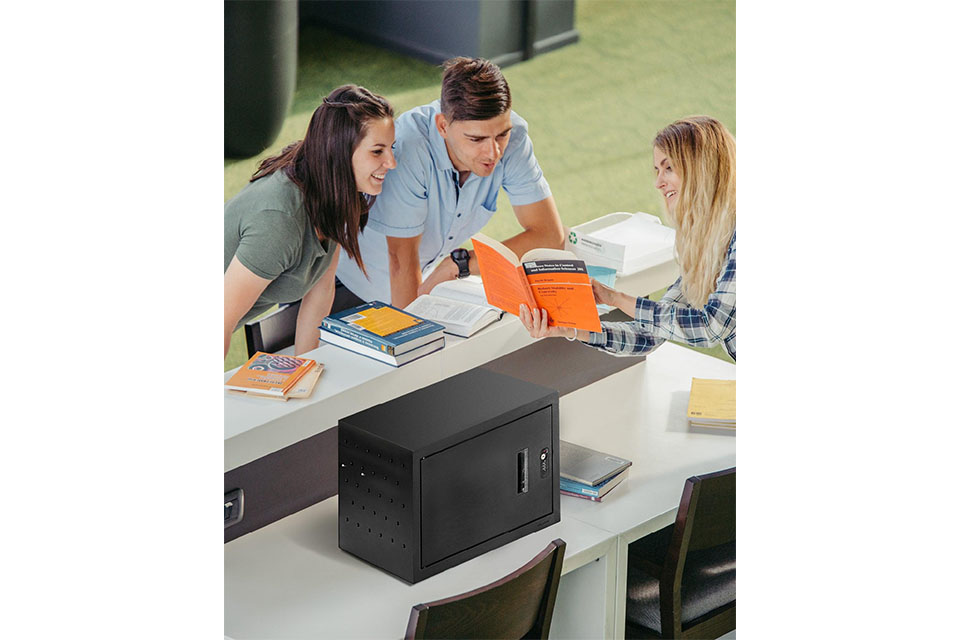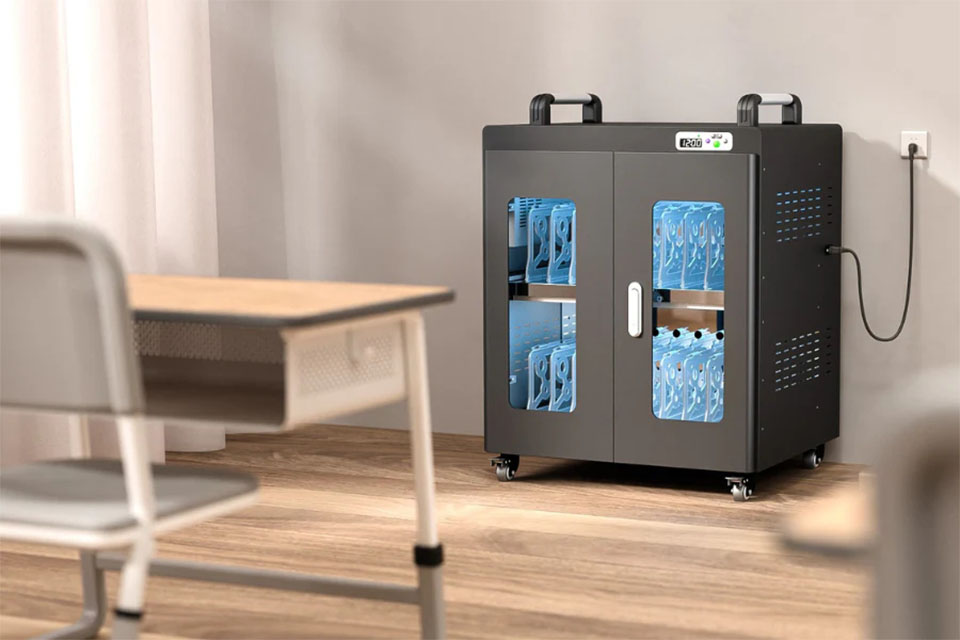Beyond the Battery: How Smart Charging Cabinets Boost Classroom Productivity
Summary
Beyond the Battery: How Smart Charging Cabinets Boost Classroom Productivity explores the transformative role of smart charging cabinets in educational settings. These innovative solutions are designed to streamline the management and charging of multiple devices, which is essential in today's technology-driven classrooms. By facilitating centralized device storage, enhancing security, and promoting energy efficiency, smart charging cabinets are increasingly recognized as pivotal tools for improving productivity and learning outcomes in educational institutions worldwide.
Notably, smart charging cabinets address common challenges faced by educators and students, such as device mismanagement and inadequate charging infrastructure. Their user-friendly designs include features like intuitive interfaces and charging indicator lights that enhance usability and accessibility, ensuring devices are always ready for use when needed. Furthermore, the cabinets promote environmental sustainability through smart charging technology that minimizes energy waste by automatically halting the charging process once devices reach full power.
Controversies surrounding smart charging cabinets primarily focus on issues of cost and implementation. While many institutions recognize the long-term benefits of investing in such technology, the initial expenditure can be a barrier for some schools, particularly those with limited budgets. Additionally, the integration of smart charging solutions into existing infrastructures may require further training and adaptation from educators and IT staff, which can be met with resistance or logistical challenges.
As educational environments continue to evolve, the adoption of smart charging cabinets represents a significant advancement in optimizing the use of technology in classrooms. By supporting effective power management and enhancing the security of devices, these cabinets not only boost classroom productivity but also pave the way for innovative learning experiences that engage students and prepare them for a tech-savvy future.
Features of Smart Charging Cabinets
Smart charging cabinets are designed to provide a seamless and efficient charging experience for a wide range of devices, enhancing productivity in various environments, including educational institutions. These cabinets come equipped with several key features that contribute to their usability and effectiveness.
Energy Efficiency
One of the prominent features of modern smart charging cabinets is their energy-efficient design. Many models incorporate smart charging technology that automatically stops the charging process once devices are fully charged, thereby reducing energy waste and contributing to a greener environment. This intelligent energy management not only helps to lower electricity costs but also promotes sustainable practices within educational settings.
Centralized Device Management
Smart charging cabinets facilitate centralized storage, allowing all devices to be securely stored and charged in one location. This organization simplifies the distribution and collection process for educators and IT administrators, ensuring that devices are readily available when needed. Moreover, the modular design of these cabinets allows for flexibility, enabling users to customize configurations based on specific requirements or available space.
Enhanced Security Features
Security is a critical concern in environments where valuable technology is in use. Smart charging cabinets often feature robust locking mechanisms and secure storage capabilities to protect devices from theft and damage. For example, locking modular storage cabinets ensure that each student's device is safeguarded while charging, enhancing peace of mind for both educators and students. Furthermore, smart locker systems equipped with internet connectivity allow for real-time monitoring of device status, enhancing security and management efficiency across multiple locations.
User-Friendly Design
The user experience is a significant consideration in the design of smart charging cabinets. Features such as clear labeling, intuitive interfaces, and charging indicator lights enhance usability, making it easy for users to operate the systems. Charging indicator lights, for instance, signal red when devices are charging and green when they are fully charged, providing users with immediate visibility of device status. This thoughtful design promotes regular use and ensures that devices remain charged and ready for educational activities.
Customization Options
To cater to the unique needs of different educational environments, smart charging cabinets offer customization options. Schools can configure their charging stations to support a variety of devices, ensuring that every student has access to the necessary technology. This adaptability is crucial in fostering an engaging learning atmosphere and optimizing resource utilization, ultimately benefiting both educators and students.
Benefits of Smart Charging Cabinets
Smart charging cabinets offer a multitude of benefits that significantly enhance the efficiency and effectiveness of various environments, particularly in educational and corporate settings.
Improved Device Management
One of the primary advantages of smart charging cabinets is their ability to provide efficient device management. These cabinets serve as a centralized location for storing and charging multiple devices simultaneously, allowing educators and IT staff to easily track and manage equipment. This centralized storage not only simplifies the distribution and collection of devices but also ensures that they are always charged and ready for use, thereby reducing downtime and increasing productivity.
Enhanced Security and Monitoring
Smart charging cabinets are equipped with advanced security features that protect valuable electronic devices. By restricting access to authorized users, these cabinets minimize the risk of theft or damage. Furthermore, many models include real-time monitoring functions that allow managers to oversee device usage, ensuring that equipment is used safely and effectively in public spaces such as schools, malls, and airports.
Energy Efficiency
Modern smart charging cabinets incorporate energy-efficient technology that minimizes energy waste. Smart charging features can automatically stop the charging process once devices are fully charged, contributing to a greener environment by reducing unnecessary energy consumption. This aspect not only supports sustainability goals but also translates into cost savings for organizations that manage large numbers of devices.
Increased Employee and Student Satisfaction
In corporate environments, providing secure charging solutions has been shown to improve employee satisfaction and efficiency. Smart charging cabinets enable employees to charge their personal devices securely at work, encouraging a more productive and stress-free work atmosphere. In educational settings, these cabinets enhance the learning experience by ensuring that students have reliable access to charged devices, which is critical in today's technology-driven classrooms.
Flexibility and Customization
Another significant benefit of smart charging cabinets is their flexibility and customization options. These cabinets can be tailored to fit the specific needs of an organization, with separate modules that can be combined into various configurations based on the number of devices and usage requirements. This adaptability makes them suitable for a wide range of settings, from schools to corporate offices and public spaces.
Implementation in Classrooms
The integration of smart charging cabinets in educational settings has shown significant potential to enhance classroom productivity and streamline learning experiences. These cabinets not only provide secure storage for devices such as tablets but also ensure that they are charged and ready for use when needed, thereby reducing downtime and fostering a more efficient learning environment.
Benefits of Smart Charging Solutions
Smart charging cabinets facilitate the management of technological resources within the classroom. As noted in studies, effective power solutions are critical for student success, as they align with the growing trend of technology-driven curricula. Schools equipped with charging cabinets can better support the implementation of digital resources, which are essential for collaborative learning and inquiry-based activities among students. The configuration of Internet access and digital resources tailored for each student enhances their engagement and learning outcomes.
Practical Applications
The use of charging cabinets is particularly beneficial in classrooms that employ mobile devices for educational purposes. For instance, a school utilizing 500 tablets across various classrooms can leverage these cabinets to ensure devices are charged and ready for lessons, minimizing disruptions caused by low battery life. Furthermore, studies suggest that a well-structured classroom environment, supported by smart technology, positively influences student perceptions of classroom climate, which in turn affects their learning processes.
Future Considerations
As educational institutions continue to adopt smart classroom technologies, future research is necessary to explore how to effectively match these technologies with pedagogical strategies. This could involve investigating the patterns of teaching and learning activities in smart classrooms to optimize their design and functionality. Implementing qualitative methods, such as classroom observations and interviews, may provide deeper insights into the effects of these technologies on student achievements and classroom dynamics.
Comparison with Traditional Charging Methods
Convenience and Accessibility
Smart charging cabinets significantly enhance the convenience of device charging compared to traditional methods. Unlike standard charging stations, which may require users to find available outlets or deal with tangled cords, smart cabinets provide organized and easily accessible charging solutions. This familiarity allows users, such as students, to quickly charge their devices without confusion or delay. Moreover, having a dedicated location for charging can streamline the process, ensuring that devices are consistently charged and ready for use.
Enhanced Security Features
Traditional charging methods often lack adequate security, leaving devices vulnerable to theft or damage. In contrast, smart charging cabinets typically incorporate advanced security features, such as locking mechanisms and user authentication systems. This added security not only protects valuable educational technology but also provides peace of mind for users and administrators alike. As schools increasingly rely on technology for educational purposes, the importance of secure charging solutions becomes even more pronounced.
Efficient Power Management
Smart charging solutions employ intelligent cycle and adaptive charging technologies that optimize power distribution and reduce energy consumption. Traditional chargers generally do not offer such capabilities, potentially leading to inefficient charging and increased electricity costs. By managing the charging process more effectively, smart cabinets can support a larger number of devices without overwhelming the available power supply, thus enhancing the overall efficiency of the charging environment.
User Satisfaction and Feedback
User testimonials indicate that smart charging cabinets contribute positively to the educational experience. Many educators and IT administrators have noted improvements in device management and user satisfaction since implementing these solutions. In contrast, traditional charging methods often result in frustration due to issues like uncharged devices or mismanaged charging times. Smart charging cabinets simplify daily device distribution and usage, enhancing both teaching and learning experiences.
Versatility in Design
Smart charging cabinets are designed with adaptability in mind, allowing for customization based on the unique needs of different educational environments. Traditional charging solutions typically lack this level of versatility, which can lead to inefficiencies in managing various devices. With features like mobile device baskets and status indicator lights, smart cabinets cater to the diverse requirements of modern classrooms, supporting a range of devices and usage scenarios.
Future Trends in Smart Charging Solutions
The landscape of smart charging solutions is evolving rapidly, driven by advancements in technology and the increasing integration of digital tools in educational settings. As schools continue to enhance their technological capabilities, the demand for innovative charging cabinets and solutions is expected to rise significantly.
Adaptive Charging Technologies
One of the key trends is the implementation of adaptive charging technologies that optimize the charging process. Modern charging solutions utilize intelligent cycle management and smart charging features to distribute power evenly among devices, maximizing efficiency and minimizing energy waste. These features not only enhance the lifespan of devices but also simplify the management of multiple devices, as they automatically shut off charging once complete.
Increased Capacity and Versatility
The versatility of charging carts is another noteworthy trend. Many contemporary models support a wide range of devices, accommodating anywhere from 16 to 42 devices including tablets, Chromebooks, and laptops up to 15 inches in screen size. Furthermore, innovations such as daisy-chain capabilities allow multiple cabinets to be linked, expanding charging capacity up to 24 devices, thus addressing the growing needs of modern classrooms.
Customization and Flexibility
Customization is increasingly becoming a hallmark of smart charging solutions. Many manufacturers are offering adjustable slot designs that allow educational institutions to tailor their carts according to specific classroom requirements. This flexibility enables schools to manage their technology effectively, ensuring that devices are securely stored and easily accessible.
Integration with Classroom Technology
As technology continues to permeate educational environments, the integration of smart charging solutions with other classroom tools is becoming more common. For example, charging cabinets are being designed to sync applications while charging devices simultaneously through USB ports, facilitating seamless user experiences. Such integration is crucial as schools strive to create efficient and effective learning environments that leverage technology for enhanced educational outcomes.
Sustainability and Energy Efficiency
With an increasing emphasis on sustainability, future smart charging solutions are likely to prioritize energy efficiency. As educational institutions look to reduce their carbon footprints, charging cabinets that incorporate renewable energy sources and energy-saving features will become more prevalent. These innovations not only contribute to environmental goals but also help schools manage their operational costs effectively.
 Mobile Charging Cabinets: Power on the Go for Exhibitions and Concerts
Mobile Charging Cabinets: Power on the Go for Exhibitions and Concerts
 How Charging Cabinets Improve Attendee Experience at Conferences
How Charging Cabinets Improve Attendee Experience at Conferences
 Declutter Your Office: The Role of Charging Cabinets in Modern Workspaces
Declutter Your Office: The Role of Charging Cabinets in Modern Workspaces

